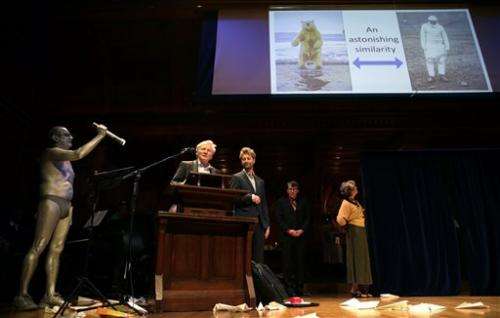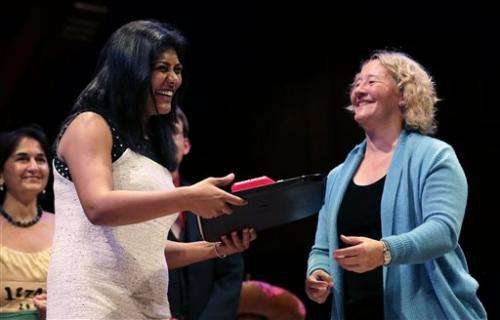Ig Nobel winner: Using pork to stop nosebleeds

There's some truth to the effectiveness of folk remedies and old wives' tales when it comes to serious medical issues, according to findings by a team from Detroit Medical Center.
Dr. Sonal Saraiya and her colleagues in Michigan found that packing strips of cured pork in the nose of a child who suffers from uncontrollable, life-threatening nosebleeds can stop the hemorrhaging, a discovery that won them a 2014 Ig Nobel prize, the annual award for sometimes inane, yet often surprisingly practical, scientific discoveries.
This year's winners honored Thursday at Harvard University by the Annals of Improbable Research magazine included a team of researchers who wondered if owning a cat was bad for your mental health; Japanese scientists who tested whether banana peels are really as slippery as cartoons would have us believe; and Norwegian biologists who tested whether reindeer on the Arctic archipelago of Svalbard were frightened by humans dressed to resemble polar bears.
As has become the custom, real Nobel laureates handed out the prizes and winners were given a maximum of 60 seconds to deliver their acceptance speech,
Sticking pork products up the patient's nose was a treatment of last resort when conventional treatments had failed, Saraiya said, and was only used for a very specific condition known as Glanzmann thrombasthenia, a rare condition in which blood does not properly clot.
"We had to do some out-of-the-box thinking," she said. "So that's where we put our heads together and thought to the olden days and what they used to do."

The 4-year-old child's nostrils were packed with cured pork twice, and according to their study, "the nasal vaults successfully stopped nasal hemorrhage promptly (and) effectively."
The method worked because "there are some clotting factors in the pork ... and the high level of salt will pull in a lot of fluid from the nose," she said.
Still, Soraiya does not recommend sticking pork up your nose for a routine nosebleed, as it could cause infection.
Kiyoshi Mabuchi, a professor of biomedical engineering at Kitasato University in Japan, studied the slipperiness of banana peels as an extension of his research into human joint lubrication system.
"I have gotten ... evidence that the friction under banana peels is sufficiently low to make us slip," Mabuchi said via email.
The other good thing about his study is that his colleagues got to eat the bananas.

Several scientists won for studying the mental health of cat owners. The bottom line? Owning a cat may be hazardous to your health.
Dr. David Hanauer, of the department of pediatrics at the University of Michigan and co-author of one of the studies, says there's no reason for cat owners to panic.
"It may simply be that people with depression gets cats because they feel depressed," he said. "I am in no way telling people to get rid of their cats."

Professor Kang Lee at the University of Toronto in Canada was part of a team that won for studying the reactions of people who see human faces in slices of toast. Although the title of the study was called "Seeing Jesus in Toast," no actual images of Jesus were shown. But the study found that in people who merely think they see a face in a slice of toast—or in any other unusual object—the part of the brain involved in facial recognition lights up.
Although his research has legitimate scientific value, he said he's thrilled to win an Ig Nobel.

Winners of the 2014 Ig Nobel Awards
The 2014 Ig Nobel winners, awarded Thursday at Harvard University by the Annals of Improbable Research magazine:
PHYSICS: Kiyoshi Mabuchi, Kensei Tanaka, Daichi Uchijima and Rina Sakai for studying the slipperiness of banana peels.
NEUROSCIENCE: Jiangang Liu, Jun Li, Lu Feng, Ling Li, Jie Tian and Kang Lee, for their study "Seeing Jesus in Toast," and trying to understand what happens in the brains of people who see human faces in a piece of toast.
PSYCHOLOGY: Peter K. Jonason, Amy Jones and Minna Lyons, for figuring out that people who habitually stay up late tend to be more self-admiring, more manipulative and more psychopathic than people who habitually arise early.
PUBLIC HEALTH: Jaroslav Flegr, Jan Havlicek and Jitka Hanusova-Lindova, and to David Hanauer, Naren Ramakrishnan and Lisa Seyfried, for investigating whether it is mentally hazardous to own a cat.
BIOLOGY: Vlastimil Hart, Petra Novakova, Erich Pascal Malkemper, Sabine Begall, Vladimir Hanzal, Milos Jezek, Tomas Kusta, Veronika Nemcova, Jana Adamkova, Katerina Benediktova, Jaroslav Cerveny and Hynek Burda, for carefully documenting that dogs align themselves with earth's magnetic field when defecating.
ART: Marina de Tommaso, Michele Sardaro and Paolo Livrea, for measuring the relative pain people suffer while looking at an ugly painting, rather than a pretty painting, while a laser beam is aimed at their hand.
ECONOMICS: Italy's National Institute of Statistics for taking the lead in fulfilling the European Union mandate to increase the official size of its national economy by including revenues from prostitution, illegal drug sales, smuggling, and other unlawful financial transactions.
MEDICINE: Ian Humphreys, Sonal Saraiya, Walter Belenky and James Dworkin, for treating "uncontrollable" nosebleeds with strips of-cured pork.
ARCTIC SCIENCE: Eigil Reimers and Sindre Eftestol, for testing how reindeer react to humans disguised as polar bears.
NUTRITION: Raquel Rubio, Anna Jofra, Belen Martin, Teresa Aymerich and Margarita Garriga, for their study of using infant fecal bacteria as potential probiotic starter cultures for fermented sausages.
-

Dr. Sonal Saraiya, left, accepts the Ig Nobel Prize for Medicine from Nobel Laureate Carol Greider during a performance at the Ig Nobel Prize ceremony at Harvard University, in Cambridge, Mass.,Thursday, Sept. 18, 2014. Saraiya and her colleagues in Michigan found that packing strips of cured pork in the nose of a child who suffers from uncontrollable, life-threatening nosebleeds can stop the hemorrhaging. The Ig Nobel prize is an award handed out by the Annals of Improbable Research magazine for silly sounding scientific discoveries that often have surprisingly practical applications. (AP Photo/Charles Krupa) -

Nobel Laureates Eric Maskin, left, and Rich Roberts examine sausages during a performance at the Ig Nobel Prize ceremony at Harvard University, in Cambridge, Mass.,Thursday, Sept. 18, 2014. A group of Spanish researchers were awarded the nutrition prize for their study titled "Characterization of Lactic Acid Bacteria Isolated from Infant Faeces as Potential Probiotic Starter Cultures for Fermented Sausages." The Ig Nobel prize is an award handed out by the Annals of Improbable Research magazine for silly sounding scientific discoveries that often have surprisingly practical applications. (AP Photo/Charles Krupa) -

Gary Dryfoos demonstrates the effectiveness of packing strips of cured pork in his nose to stop uncontrollable, life-threatening nosebleeds during a performance at the Ig Nobel Prize ceremony at Harvard University, in Cambridge, Mass.,Thursday, Sept. 18, 2014. The Ig Nobel prize is an award handed out by the Annals of Improbable Research magazine for silly sounding scientific discoveries that often have surprisingly practical applications. (AP Photo/Charles Krupa) -

Master of Ceremonies Marc Abrahams holds up the 2014 Ig Nobel Prize trophy during a performance at the Ig Nobel Prize ceremony at Harvard University, in Cambridge, Mass.,Thursday, Sept. 18, 2014. The Ig Nobel prize is an award handed out by the Annals of Improbable Research magazine for silly sounding scientific discoveries that often have surprisingly practical applications. (AP Photo/Charles Krupa)
More information: 2014 Ig Nobels, www.improbable.com/ig/2014
© 2014 The Associated Press. All rights reserved.


















